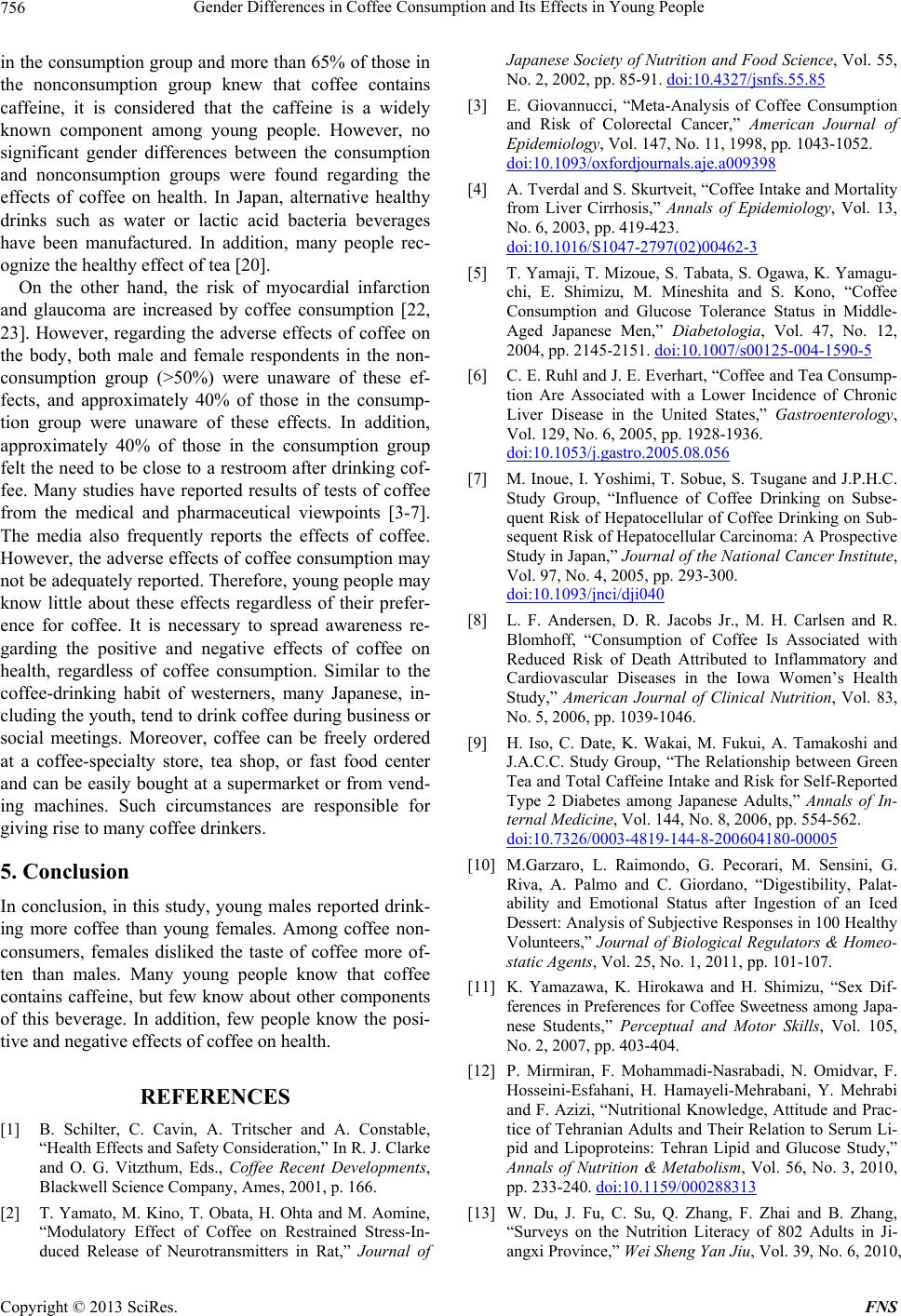
Gender Differences in Coffee Consumption and Its Effects in Young People
756
in the consumption group and more than 65% of those in
the nonconsumption group knew that coffee contains
caffeine, it is considered that the caffeine is a widely
known component among young people. However, no
significant gender differences between the consumption
and nonconsumption groups were found regarding the
effects of coffee on health. In Japan, alternative healthy
drinks such as water or lactic acid bacteria beverages
have been manufactured. In addition, many people rec-
ognize the healthy effect of tea [20].
On the other hand, the risk of myocardial infarction
and glaucoma are increased by coffee consumption [22,
23]. However, regarding the adverse effects of coffee on
the body, both male and female respondents in the non-
consumption group (>50%) were unaware of these ef-
fects, and approximately 40% of those in the consump-
tion group were unaware of these effects. In addition,
approximately 40% of those in the consumption group
felt the need to be close to a restroom after drinking cof-
fee. Many studies have reported results of tests of coffee
from the medical and pharmaceutical viewpoints [3-7].
The media also frequently reports the effects of coffee.
However, the adverse effects of coffee consumption may
not be adequately reported. Therefore, young people may
know little about these effects regardless of their prefer-
ence for coffee. It is necessary to spread awareness re-
garding the positive and negative effects of coffee on
health, regardless of coffee consumption. Similar to the
coffee-drinking habit of westerners, many Japanese, in-
cluding the youth, tend to drink coffee during business or
social meetings. Moreover, coffee can be freely ordered
at a coffee-specialty store, tea shop, or fast food center
and can be easily bought at a supermarket or from vend-
ing machines. Such circumstances are responsible for
giving ri s e to many cof f ee drinkers.
5. Conclusion
In conclusion, in this study, young males reported drink-
ing more coffee than young females. Among coffee non-
consumers, females disliked the taste of coffee more of-
ten than males. Many young people know that coffee
contains caffeine, but few know about other components
of this beverage. In addition, few people know the posi-
tive and negative effects of coffee on health.
REFERENCES
[1] B. Schilter, C. Cavin, A. Tritscher and A. Constable,
“Health Effects and Safety Consideration,” In R. J. Clarke
and O. G. Vitzthum, Eds., Coffee Recent Developments,
Blackwell Science Company, Ames, 2001, p. 166.
[2] T. Yamato, M. Kino, T. Obata, H. Ohta and M. Aomine,
“Modulatory Effect of Coffee on Restrained Stress-In-
duced Release of Neurotransmitters in Rat,” Journal of
Japanese Society of Nutrition and Food Science, Vol. 55,
No. 2, 2002, pp. 85-91. doi:10.4327/jsnfs.55.85
[3] E. Giovannucci, “Meta-Analysis of Coffee Consumption
and Risk of Colorectal Cancer,” American Journal of
Epidemiology, Vol. 147, No. 11, 1998, pp. 1043-1052.
doi:10.1093/oxfordjournals.aje.a009398
[4] A. Tverdal and S. Skurtveit, “Coffee Intake and Mortality
from Liver Cirrhosis,” Annals of Epidemiology, Vol. 13,
No. 6, 2003, pp. 419-423.
doi:10.1016/S1047-2797(02)00462-3
[5] T. Yamaji , T. Mizoue, S. Tabata, S. Ogawa, K. Yamagu-
chi, E. Shimizu, M. Mineshita and S. Kono, “Coffee
Consumption and Glucose Tolerance Status in Middle-
Aged Japanese Men,” Diabetologia, Vol. 47, No. 12,
2004, pp. 2145-2151. doi:10.1007/s00125-004-1590-5
[6] C. E. Ruhl and J. E. Everhart, “Coffee and Tea Consump-
tion Are Associated with a Lower Incidence of Chronic
Liver Disease in the United States,” Gastroenterology,
Vol. 129, No. 6, 2005, pp. 1928-1936.
doi:10.1053/j.gastro.2005.08.056
[7] M. Inoue, I. Yoshimi, T. Sobue, S. Tsugane and J.P.H.C.
Study Group, “Influence of Coffee Drinking on Subse-
quent Risk of Hepatocellular of Coffee Drinking on Sub-
sequent Risk of Hepatocellular Carcinoma: A Prospective
Study in Japan,” Journal of the National Cancer Institute,
Vol. 97, No. 4, 2005, pp. 293-300.
doi:10.1093/jnci/dji040
[8] L. F. Andersen, D. R. Jacobs Jr., M. H. Carlsen and R.
Blomhoff, “Consumption of Coffee Is Associated with
Reduced Risk of Death Attributed to Inflammatory and
Cardiovascular Diseases in the Iowa Women’s Health
Study,” American Journal of Clinical Nutrition, Vol. 83,
No. 5, 2006, pp. 1039-1046.
[9] H. Iso, C. Date, K. Wakai, M. Fukui, A. Tamakoshi and
J.A.C.C. Study Group, “The Relationship between Green
Tea and Total Caffeine Intake and Risk for Self-Reported
Type 2 Diabetes among Japanese Adults,” Annals of In-
ternal Medicine, Vol. 144, No. 8, 2006, pp. 554-562.
doi:10.7326/0003-4819-144-8-200604180-00005
[10] M.Garzaro, L. Raimondo, G. Pecorari, M. Sensini, G.
Riva, A. Palmo and C. Giordano, “Digestibility, Palat-
ability and Emotional Status after Ingestion of an Iced
Dessert: Analysis of Subjective Responses in 100 Healthy
Volunteers,” Journal of Biological Regulators & Homeo-
static Agents, Vol. 25, No. 1, 2011, pp. 101-107.
[11] K. Yamazawa, K. Hirokawa and H. Shimizu, “Sex Dif-
ferences in Preferences for Coffee Sweetness among Japa-
nese Students,” Perceptual and Motor Skills, Vol. 105,
No. 2, 2007, pp. 403-404.
[12] P. Mirmiran, F. Mohammadi-Nasrabadi, N. Omidvar, F.
Hosseini-Esfahani, H. Hamayeli-Mehrabani, Y. Mehrabi
and F. Azizi, “Nutritional Knowledge, Attitude and Prac-
tice of Tehranian Adults and Their Relation to Serum Li-
pid and Lipoproteins: Tehran Lipid and Glucose Study,”
Annals of Nutrition & Metabolism, Vol. 56, No. 3, 2010,
pp. 233-240. doi:10.1159/000288313
[13] W. Du, J. Fu, C. Su, Q. Zhang, F. Zhai and B. Zhang,
“Surveys on the Nutrition Literacy of 802 Adults in Ji-
angxi Province,” Wei Sheng Yan Jiu, Vol. 39, No. 6, 2010,
Copyright © 2013 SciRes. FNS